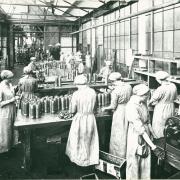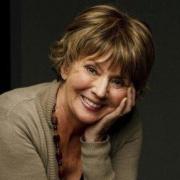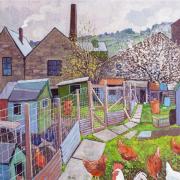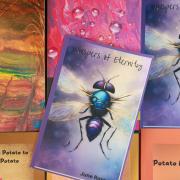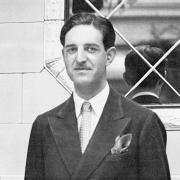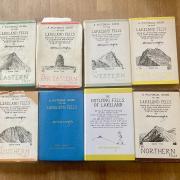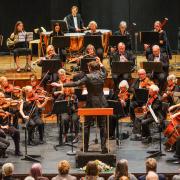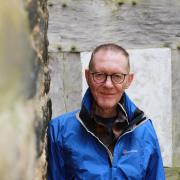It's 200 year since William Wordsworth moved to Rydal Mount and unwittingly created the Lake District's first tourist attraction. Eileen Jones reports
William Wordsworth once wrote that if he failed to make a success of poetry, his second love was landscape gardening. England’s most celebrated poet is recognised for his celebration of nature, and in particular certain yellow flowers that bloom in the spring. What’s not so widely know is that he had an eye for design and the skill with a spade to create beautiful gardens.
Peter and Marian Elkington are curators of Rydal Mount, the house where Wordsworth spent the happiest days of his life and they are making every effort to keep the gardens as close to the way the poet intended.
It was in 200 years ago in May that Wordsworth with his wife Mary, his sister Dorothy and daughter Dora, moved here from the uncomfortable Parsonage in Grasmere to this elegant and spacious house on a hill on the outskirts of Ambleside.
It was a turning point in his life, when the family could move on from the unhappiness and tragedy that had marred the years in Grasmere, and where the poet could find new inspiration in the light, bright rooms of Rydal Mount.
It was also the month he became a civil servant in Ambleside, working as a Distributor of Stamps for items such as legal documents, books and newspapers. It enabled him to earn enough to write and live in comfort.
‘It wasn’t a very big salary. He was paid £400 a year and, according to Dorothy’s Journal, at first it took up two thirds of his time. But it gave him the security for his creativity to re-surface,’ says Peter Elkington.
His critics maintained that he had ‘sold out’ but he was clearly happier and more settled at Rydal Mount than at any other time. Now, with a position in society as well as a growing reputation as a poet, Wordsworth set about decorating his ideal home, where was to live for 37 years from 1813 until his death in 1850.
He furnished it mostly with second hand items bought from country sales, though the Turkish carpets were new. He was inclined to invite passing visitors in ‘so, in effect, Rydal Mount was the first tourist attraction in the Lakes,’ says Peter. ‘Wordsworth was already famous by then.’
Rydal Mount was bought in 1969 by the great great-granddaughter of the poet and opened to the public a year later. Peter and Marian, from South Africa, moved in 20 years ago. Living here one feels the atmosphere, says Peter. ‘It’s a very different experience from just studying his work.’
He is talking beneath the only known portrait in oils of Dorothy Wordsworth dated 1833 when Dorothy was elderly and frail-looking.One curious portrait on the drawing room wall is a copy of Wordsworth, painted by Henry Inman. The original is in America and it was commissioned when Wordsworth reluctantly agreed to became Poet Laureate.
Peter and Marian have added to the collections in the house with items they find at auctions and sales, such as a letter opener containing a snip of Dora’s hair. A small team of staff take pride in guiding groups around and arranging flowers from the garden in the different rooms. Peter and Marian host poetry readings and book launches, and are licensed to hold wedding ceremonies. There is also a small tearoom, serving home made cakes, in what was once Dora’s schoolroom.
Out in the grounds, the staff work tirelessly, using sketches found shortly after Wordsworth’s death to restore and maintain the garden to his original vision. They are led by head gardener Helen Green, who has won awards for her work here, and visitors can enjoy rhododendrons, azaleas, a range of exotic fuchsias and, of course, daffodils.
Dora’s field, adjacent to Rydal Mount is famed for its early flowering every year of tiny, wild daffodils. Wordsworth had bought the land intending to build a house on it, but the plan wasn’t followed through. He and Mary planted the daffodil bulbs there in 1847 in memory of their daughter Dora who died at the age of 43 at Rydal Mount.
These are not the daffodils of Wordsworth’s tribute, possibly the most famous poem in the world, which had been written earlier.
‘We have visitors from Japan who ask if they can recite Daffodils in English to us, and they do so meticulously,’ says Peter, who can – hesitantly – read a few lines of the poem in Japanese. It was here at Rydal Mount that Wordsworth revised and published the version of the poem that we all now know. It had been written back in 1804 but Wordsworth wasn’t satisfied and the new version was published in 1815 from Rydal Mount.
There are celebrations planned to mark the bi-centenary of Wordsworth’s move to Rydal Mount and one of them is designed to encourage a new generation of Lakes poets. Together with Stampers Restaurant in Ambleside, based in the Old Stamp House where Wordsworth worked, Rydal Mount is sponsoring a poetry competition for pupils at the two local schools, Ambleside Primary and The Lakes secondary school, a couple of miles south of Ambleside. The youngsters are encouraged to visit Rydal. ‘You can’t help but be inspired here,’ says Peter.
Have a wander
The dining room at Rydal was originally part of an old Tudor cottage, complete with stone flagged floor and oak beams. However, it was added to in the 1750s creating areas with larger proportions in the library and drawing room.Visitors can look around the family bedrooms and Wordsworth’s study in the attic. The house is open daily from March 1 from 9.30am to 5.00pm and adult entrance costs £6.75. For more information go to www.rydalmount.co.uk






